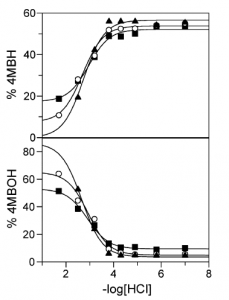 20 September 2010
20 September 2010
 Org Biomol Chem 8 (23), 5304-5312. .
Org Biomol Chem 8 (23), 5304-5312. .
 Alejandra Fernández-Alonsoa, María José Pastoriza-Gallegoa, Carlos Bravo-Díaz*a
Alejandra Fernández-Alonsoa, María José Pastoriza-Gallegoa, Carlos Bravo-Díaz*a
 Autor affilations:
Autor affilations:
*Corresponding authors
aDpt. Química Física, Facultad de Química, Universidad de Vigo, Vigo-Pontevedra, Spain
![]() E-mail: cbravo@uvigo.es
E-mail: cbravo@uvigo.es
Abstract
We investigated the effects of solvent composition, acidity and temperature on the switch between heterolytic and homolytic mechanisms in the course of the butanolysis of 4-methylbenzenediazonium (4MBD) ions in binary BuOH/H(2)O mixtures and in reverse micelles, RMs, composed of n-BuOH, H(2)O and sodium dodecyl sulfate, SDS, by employing a combination of spectrometric (UV/vis) and chromatographic (HPLC) techniques. In reaction mixtures with high n-BuOH percentages, S-shaped variations of k(obs) with acidity, defined hereafter as -log([HCl]), are obtained with rate enhancements of up to ∼370-fold on going from -log([HCl]) = 2 to 6, with inflection points at -log[HCl] ∼ 4. HPLC analyses of the reaction mixtures show that the substitution product 4-cresol, ArOH and the reduction product toluene, ArH, are formed competitively. The variation of their yields with acidity is also S-shaped, so that at high acidities (-log[HCl] < 3) only traces of ArH are detected but on lowering the acidity, the reduction product ArH becomes predominant The largest variations of k(obs) and of the product yields with acidity are found in the -log[HCl] = 3-5 range, suggesting that a turnover in the dediazoniation mechanism takes place under acidic conditions. The results can be interpreted in terms of two competitive reaction pathways, one heterolytic, involving a rate-determining formation of an extremely reactive aryl cation that traps the nucleophiles available in its solvation shell leading to the formation of substitution products (D(N) + A(N) mechanism) and a second route where the BuOH reacts with 4MBD to yield an unstable O-adduct of the type Ar-N[double bond, length as m-dash]N-O-R (diazo ether) in a rapid pre-equilibrium step that initiates a radical process leading to the formation of the reduction product ArH (O-coupling mechanism). The results illustrate how the heterolytic and homolytic mechanisms can be switched by just changing the acidity of the solution. Kinetic analyses of the variations of k(obs) with acidity at different temperatures allowed us to separate k(obs) into the components for the heterolytic pathway, k(HET), and that for the homolytic one, k(HOM), to determine relevant thermodynamic parameters for both reaction pathways and for the equilibrium constant K for the formation of the O-adduct Ar-N=N-O-R.

